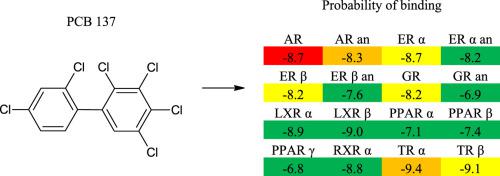Ecotoxicology and Environmental Safety ( IF 6.2 ) Pub Date : 2021-02-25 , DOI: 10.1016/j.ecoenv.2021.112086 Lukman K Akinola 1 , Adamu Uzairu 2 , Gideon A Shallangwa 2 , Stephen E Abechi 2

|
Production of polychlorinated biphenyls (PCBs) was banned a long time ago because of their harmful health effects but humans continue to be exposed to residual PCBs in the environment. In this study, the susceptibility of human nuclear receptors to binding by PCBs was investigated using molecular docking simulation. Findings revealed that PCBs belonging to ortho-substituted, mono-ortho-substituted and non-ortho-substituted congeners could bind to agonistic conformations of androgen (AR), estrogen (ER α and ER β), glucocorticoid (GR) and thyroid hormone (TR α and TR β) receptors as well as antagonistic conformation of androgen receptor (AR an) but only ortho-substituted and mono-ortho-substituted PCBs could bind to estrogen receptors in their antagonistic conformations (ER α an and ER β an). Further molecular docking analyses showed that PCBs mimic the modes of interaction observed for the co-crystallized ligands in the crystal structures of the affected receptors, utilizing 81%, 83%, 78%, 60%, 75%, 60%, 86%, 100% and 75% of the amino acid residues utilized by the co-crystallized ligands for binding in AR, AR an, ER α, ER α an, ER β, ER β an, GR, TR α and TR β respectively. This computational study suggests that PCBs may cause endocrine disruption via formation of non-covalent interactions with androgen, estrogen, glucocorticoid and thyroid hormone receptors.
中文翻译:

通过与人类核受体的非共价相互作用对多氯联苯内分泌干扰的计算洞察
多氯联苯 (PCB) 的生产很久以前就被禁止,因为它们对健康有危害,但人类继续暴露于环境中残留的 PCB。在这项研究中,使用分子对接模拟研究了人类核受体对 PCB 结合的敏感性。研究结果表明,属于邻位取代、单邻位取代和非邻位取代同源物的多氯联苯可以与雄激素 (AR)、雌激素 (ER α 和 ER β)、糖皮质激素 (GR) 和甲状腺激素的激动构象结合。 TR α 和 TR β) 受体以及雄激素受体 (AR an) 的拮抗构象,但只有邻位取代和单邻位- 取代的 PCB 可以与其拮抗构象(ER α an 和 ER β an)结合到雌激素受体上。进一步的分子对接分析表明,PCB 模拟了在受影响受体的晶体结构中观察到的共结晶配体的相互作用模式,利用了 81%、83%、78%、60%、75%、60%、86%、 100% 和 75% 的氨基酸残基被共结晶配体用于结合 AR、ARan、ERα、ERαan、ERβ、ERβan、GR、TRα 和 TRβ。这项计算研究表明,PCB 可能通过与雄激素、雌激素、糖皮质激素和甲状腺激素受体形成非共价相互作用而导致内分泌紊乱。











































 京公网安备 11010802027423号
京公网安备 11010802027423号